I want to be able to draw a ellipse that is empty, on a transparent layer in a ImgView32. Any idea how to do that? So far all I can think about is:
BL := TBitmapLayer.Create(ImgView.Layers);
BL.Bitmap.DrawMode := dmTransparent;
BL.Bitmap.SetSize(imwidth,imheight);
BL.Bitmap.Canvas.Pen.Width := penwidth;
BL.Bitmap.Canvas.Pen.Color := pencolor;
BL.Location := GR32.FloatRect(0, 0, imwidth, imheight);
BL.Scaled := False;
BL.OnMouseDown := LayerMouseDown;
BL.OnMouseUp := LayerMouseUp;
BL.OnMouseMove := LayerMouseMove;
BL.OnPaint := LayerOnPaint;
...
BL.Bitmap.Canvas.Pen.Color := clBlue;
BL.Bitmap.Canvas.MoveTo(FStartPoint.X, FStartPoint.Y);
BL.Bitmap.Canvas.Ellipse(FStartPoint.X, FStartPoint.Y,FEndPoint.X, FEndPoint.Y);
The Start and End points are obtained in mouse events.
I actually am trying to draw a dynamic ellipse (on mouse events). So onMouseDown (LayerMouseDown), onMouseUp (LayerMouseUp) and OnMouseMove (LayerMouseMove) events are involved. As a refference please check this question, it deals with drawing a line dynamically. I want to do the same but with Ellipses instead of lines.
So instead of AddLineToLayer I have the AddCircleToLayer procedure The events look like this now:
procedure TForm5.SwapBuffers32;
begin
TransparentBlt(
BL.Bitmap.Canvas.Handle, 0, 0, BL.Bitmap.Width, BL.Bitmap.Height,
bm32.Canvas.Handle, 0, 0, bm32.Width, bm32.Height, clWhite);
end;
procedure TForm5.ImgViewResize(Sender: TObject);
begin
OffsX := (ImgView.ClientWidth - imwidth) div 2;
OffsY := (ImgView.ClientHeight - imheight) div 2;
BL.Location := GR32.FloatRect(OffsX, OffsY, imwidth+OffsX, imheight+OffsY);
end;
procedure TForm5.LayerMouseDown(Sender: TObject; Buttons: TMouseButton;
Shift: TShiftState; X, Y: Integer);
begin
FStartPoint := Point(X-OffsX, Y-OffsY);
FDrawingLine := true;
end;
procedure TForm5.LayerMouseMove(Sender: TObject; Shift: TShiftState; X, Y: Integer);
begin
if FDrawingLine then
begin
SwapBuffers32;
if RadioGroup1.ItemIndex=0 then
begin
BL.Bitmap.Canvas.Pen.Color := pencolor;
BL.Bitmap.Canvas.MoveTo(FStartPoint.X, FStartPoint.Y);
BL.Bitmap.Canvas.LineTo(X-OffsX, Y-OffsY);
end
else
begin
BL.Bitmap.Canvas.Pen.Color := pencolor;
BL.Bitmap.Canvas.MoveTo(FStartPoint.X, FStartPoint.Y);
SwapBuffers32;
BL.Bitmap.Canvas.Ellipse(FStartPoint.X, FStartPoint.Y,X-OffsX, Y-OffsY);
end;
end;
end;
procedure TForm5.LayerMouseUp(Sender: TObject; Buttons: TMouseButton;
Shift: TShiftState; X, Y: Integer);
begin
if RadioGroup1.ItemIndex=0 then
begin
FDrawingLine := false;
FEndPoint := Point(X-OffsX, Y-OffsY);
AddLineToLayer;
SwapBuffers32;
end
else
begin
FDrawingLine := false;
FEndPoint := Point(X-OffsX, Y-OffsY);
AddCircleToLayer;
SwapBuffers32;
end
end;
procedure TForm5.LayerOnPaint(Sender: TObject; Buffer: TBitmap32);
begin
SwapBuffers32;
end;
procedure TForm5.AddLineToLayer;
begin
bm32.Canvas.Pen.Color := pencolor;
bm32.Canvas.Pen.Width := penwidth;
bm32.Canvas.MoveTo(FStartPoint.X, FStartPoint.Y);
bm32.Canvas.LineTo(FEndPoint.X, FEndPoint.Y);
end;
procedure TForm5.AddCircleToLayer;
begin
bm32.Canvas.Pen.Color := pencolor;
bm32.Canvas.Pen.Width := penwidth;
bm32.Canvas.MoveTo(FStartPoint.X, FStartPoint.Y);
bm32.Canvas.Ellipse(FStartPoint.X, FStartPoint.Y,FEndPoint.X, FEndPoint.Y);
SwapBuffers32;
end;
But when I use this code, the circle(ellipse) is filled with white up (like in this image)
 until I start drawing the next ellipse (so onMouseMove and onMouseUp the ellipse is filled). And only when I do another onMouseDown, then the previous circle gets emptyied, but the new ellipse is also filled with white (like in this image)
until I start drawing the next ellipse (so onMouseMove and onMouseUp the ellipse is filled). And only when I do another onMouseDown, then the previous circle gets emptyied, but the new ellipse is also filled with white (like in this image)

Also if you try doing more ellipses one after the other, and onTop of the older ones, you will notice that there will be traces of the onMouseMove ellipses, like in this image:

So there must be something I am missing with this code.
Please help me solve this.